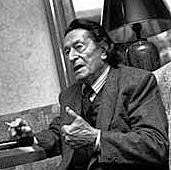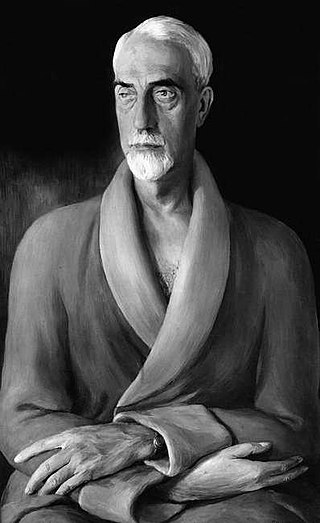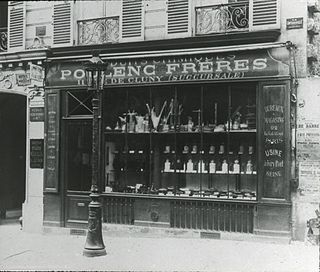
Francis Jean Marcel Poulenc was a French composer and pianist. His compositions include songs, solo piano works, chamber music, choral pieces, operas, ballets, and orchestral concert music. Among the best-known are the piano suite Trois mouvements perpétuels (1919), the ballet Les biches (1923), the Concert champêtre (1928) for harpsichord and orchestra, the Organ Concerto (1938), the opera Dialogues des Carmélites (1957), and the Gloria (1959) for soprano, choir, and orchestra.

Hoechst AG was a German chemicals, later life sciences, company that became Aventis Deutschland after its merger with France's Rhône-Poulenc S.A. in 1999. With the new company's 2004 merger with Sanofi-Synthélabo, it became a subsidiary of the resulting Sanofi-Aventis pharmaceuticals group.

Henri Laborit was a French surgeon, neurobiologist, writer and philosopher. In 1952, Laborit was instrumental in the development of the drug chlorpromazine, published his findings, and convinced three psychiatrists to test it on a patient, resulting in great success. Laborit was recognized for his work, but as a surgeon searching for an anesthetic, he came to be at odds with psychiatrists who made their own discoveries and competing claims.
ATC code N05Psycholeptics is a therapeutic subgroup of the Anatomical Therapeutic Chemical Classification System, a system of alphanumeric codes developed by the World Health Organization (WHO) for the classification of drugs and other medical products. Subgroup N05 is part of the anatomical group N Nervous system.

Promethazine, sold under the brand name Phenergan among others, is a first-generation antihistamine, antipsychotic, sedative, and antiemetic used to treat allergies, insomnia, and nausea. It may also help with some symptoms associated with the common cold and may also be used for sedating people who are agitated or anxious, an effect that has led to some recreational use. Promethazine is taken by mouth (oral), as a rectal suppository, or by injection into a muscle (IM).

Pagoclone is an anxiolytic agent from the cyclopyrrolone family, related to better-known drugs such as the sleeping medication zopiclone. It was synthesized by a French team working for Rhone-Poulenc & Rorer S.A. Pagoclone belongs to the class of nonbenzodiazepines, which have similar effects to the older benzodiazepine group, but with quite different chemical structures. It was never commercialised.

Dalfopristin is a semi-synthetic streptogramin antibiotic analogue of ostreogyrcin A. The combination quinupristin/dalfopristin was brought to the market by Rhone-Poulenc Rorer Pharmaceuticals in 1999. Synercid is used to treat infections by staphylococci and by vancomycin-resistant Enterococcus faecium.

Promazine, is used as a short-term add-on treatment for psychomotor agitation. Its approved uses in people is limited, but is used as a tranquilizer in veterinary medicine. It has weak antipsychotic effects but is generally not used to treat psychoses.
Rhône-Poulenc was a French chemical and pharmaceutical company founded in 1928. In 1999, it merged with Hoechst AG to form Aventis. As of 2015, the pharmaceutical operations of Rhône-Poulenc are part of Sanofi and the chemicals divisions are part of Solvay group and Bayer Crop Science.

Indalpine is a selective serotonin reuptake inhibitor (SSRI) class drug that was briefly marketed. It was discovered in 1977 by the pharmacologists Le Fur and Uzan at Pharmuka, a small French pharmaceutical firm, who credit Baron Shopsin and his colleagues at NYU-Bellevue/NYU School of Medicine in New York with providing the basis for their work. They were particularly influenced by the series of "synthesis inhibitor studies" carried out by Shopsin's team during the early to mid 1970s, and in particular, the clinical report by Shopsin et al. (1976) relating to PCPA's rapid reversal of antidepressant response to tranylcypromine in depressed patients. This led to an understanding of the role of the monoamine neurotransmitter serotonin in the therapeutic effects of the available tricyclic and MAOI class antidepressants. The studies led to widespread recognition of a serotonin hypothesis of depression, contradicting theories that promoted the role of norepinephrine.

Suproclone is a sedative and anxiolytic drug in the cyclopyrrolone family of drugs, developed by the French pharmaceutical company Rhône-Poulenc. Other cyclopyrrolone drugs include zopiclone, pagoclone and suriclone.

Levophacetoperane is a psychostimulant developed by Rhône-Poulenc in the 1950s. The drug has been used as an antidepressant and anorectic. It is the reverse ester of methylphenidate.

Dimetotiazine (INN) is a phenothiazine drug used for the treatment of migraine. It is a serotonin antagonist and histamine antagonist.

Perazine (Taxilan) is a moderate-potency typical antipsychotic of the phenothiazine class. It is quite similar to chlorpromazine, and acts as a dopamine antagonist. A 2014 systematic review compared it with other antipsychotic drugs:

Etymemazine is an antipsychotic, antihistamine and anticholinergic drug of the phenothiazine chemical class, structurally related to cyamemazine and methotrimeprazine.

Chlorproethazine, sold under the brand name Neuriplege, is a drug of the phenothiazine group described as a muscle relaxant or tranquilizer which is or has been marketed in Europe as a topical cream for the treatment of muscle pain. It has been associated with photoallergic contact dermatitis.

Thioproperazine, sold under the brand name Majeptil, is a typical antipsychotic of the phenothiazine group which is used as a tranquilizer, antiemetic, sedative, and in the treatment of schizophrenia and manic phase of bipolar disorder. Majeptil is available in 10 mg tablets.

Prothipendyl, also known as azapromazine or phrenotropin, is an anxiolytic, antiemetic, and antihistamine of the azaphenothiazine group which is marketed in Europe and is used to treat anxiety and agitation in psychotic syndromes. It differs from promazine only by the replacement of one carbon atom with a nitrogen atom in the tricyclic ring system. Prothipendyl is said to not possess antipsychotic effects, and in accordance, appears to be a weaker dopamine receptor antagonist than other phenothiazines.

Ernest Fourneau was a French pharmacist who graduated in 1898 for the Paris university specialist in medicinal chemistry and pharmacology. He played a major role in the discovery of synthetic local anesthetics such as amylocaine, as well as in the synthesis of suramin. He authored more than two hundred scholarly works, and has been described as having "helped to establish the fundamental laws of chemotherapy that have saved so many human lives".

Poulenc Frères was a French chemical, pharmaceutical and photographic supplies company that had its origins in a Paris pharmacy founded in 1827. From 1852 it began to manufacture photographic chemicals. It took the name Poulenc Frères in 1881, and by 1900 had a range of high-quality products. That year it went public as the Établissements Poulenc Frères. It began production of synthetic medicines, and continued to grow during World War I (1914–18). In 1928 it merged with the Société des usines chimiques du Rhône to form Rhône-Poulenc.



















